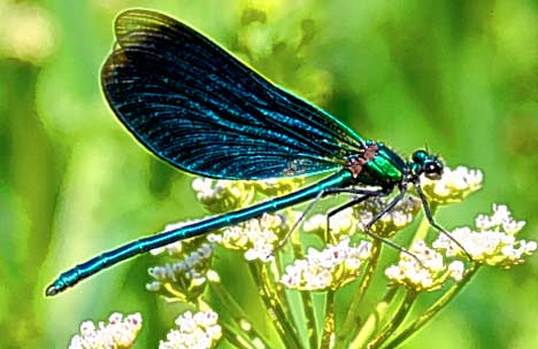Dragonflies

The Dragonflies
Many eyes watching
Darting hither and yon
Around the pond
Snatching meals
Entertaining and spritely, the dragonflies catch our attention. Scientists, too, watch them closely since they seem to be quite affected by climate change. Dragonflies are attracted to moist aquatic ponds or natural wetlands to lay their eggs. They place their eggs on suitable partially submerged plants. Their larva will live in the water, using gills to breathe until they are mature. During that time, they eat other insects and even small tadpoles or fish. They continue to eat insects throughout their adult stage. In fact, they are prized as mosquito snatchers and as contributors to insect control. Their keen multifaceted eyes spy any quick movements. With so many facets or lenses, they possess 360 degree vision.
Their double wings bless them with speeds upwards of 50 km or 30 mph, ranking them as the fastest of the insect world. However, they often camouflage themselves by appearing stationary as they hover. They are also known to migrate, up and down the western coast and have been recorded moving up to 137 km in a single day. However, the hows, whys and wherefores of their migration are currently under study. Their large eyes and elongated bodies have made dragonflies the subject of folklore in many cultures. European stories often depict them as sinister. On the other hand, Native Americans lauded them as symbols of fresh water, energy, and speed or of renewal after a time of hardship. In Japan and many other Asian countries, their images represent courage, strength and happiness.
“May you touch dragonflies & stars, dance with fairies & talk to the moon. May you grow up with love & gracious hearts & people who care”. from Nursery Wall Quotes
http://en.wikipedia.org/wiki/Dragonfly
Many eyes watching
Darting hither and yon
Around the pond
Snatching meals
Entertaining and spritely, the dragonflies catch our attention. Scientists, too, watch them closely since they seem to be quite affected by climate change. Dragonflies are attracted to moist aquatic ponds or natural wetlands to lay their eggs. They place their eggs on suitable partially submerged plants. Their larva will live in the water, using gills to breathe until they are mature. During that time, they eat other insects and even small tadpoles or fish. They continue to eat insects throughout their adult stage. In fact, they are prized as mosquito snatchers and as contributors to insect control. Their keen multifaceted eyes spy any quick movements. With so many facets or lenses, they possess 360 degree vision.
Their double wings bless them with speeds upwards of 50 km or 30 mph, ranking them as the fastest of the insect world. However, they often camouflage themselves by appearing stationary as they hover. They are also known to migrate, up and down the western coast and have been recorded moving up to 137 km in a single day. However, the hows, whys and wherefores of their migration are currently under study. Their large eyes and elongated bodies have made dragonflies the subject of folklore in many cultures. European stories often depict them as sinister. On the other hand, Native Americans lauded them as symbols of fresh water, energy, and speed or of renewal after a time of hardship. In Japan and many other Asian countries, their images represent courage, strength and happiness.
“May you touch dragonflies & stars, dance with fairies & talk to the moon. May you grow up with love & gracious hearts & people who care”. from Nursery Wall Quotes
http://en.wikipedia.org/wiki/Dragonfly
